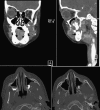The spectrum of gnathic osteosarcoma: caveats for the clinician and the pathologist
- PMID: 21046296
- PMCID: PMC3037463
- DOI: 10.1007/s12105-010-0218-y
The spectrum of gnathic osteosarcoma: caveats for the clinician and the pathologist
Abstract
Seven expansile jaw lesions in patients ranging from 7 to 63 years are presented to illustrate diagnostic and management issues pertaining to cases ultimately proven to be gnathic osteosarcoma (GO). Six of the cases in our series were low-grade osteoblastic and one high-grade chondroblastic. None of our cases exhibited the characteristic "sunburst" radiopaque appearance described for GO. All of our cases displayed cortical expansion and one showed development of diastema. Two occurred in the maxilla and five in the mandible. Two of the patients with mandibular lesions presented initially with pain; all other patients were asymptomatic. Lack of pain resulted in a delay in diagnosis due to postponement of consultation or biopsy. Two cases underwent initial shallow non-representative biopsies, requiring a second biopsy for definitive diagnosis, further delaying treatment. Those biopsies were initially interpreted as pyogenic granuloma and peripheral ossifying fibroma, respectively. GO should always be considered in the differential diagnosis of expansile jaw lesions. Bone biopsies of lesions exhibiting pain and expansion of cortical plates should include medullary bone in order to minimize sampling error. In addition, all rapidly growing or painful exophytic bone lesions, and presumed soft tissue lesions that may involve underlying bone, should be examined histopathologically, and receive clinical and radiographic follow-up until complete resolution or healing is evident, regardless of the diagnosis. Based on the positive outcomes of the patients in our series, the prognosis of GO appears to be relatively favorable when compared to other sarcomas and osteosarcomas of long bones.
Figures













Similar articles
-
Periosteal osteosarcoma of the jaws: report of 2 cases.J Periodontol. 2000 Feb;71(2):325-9. doi: 10.1902/jop.2000.71.2.325. J Periodontol. 2000. PMID: 10711625
-
Osteosarcoma of the jaw. The Chaim Sheba Medical Center experience.Oral Surg Oral Med Oral Pathol Oral Radiol Endod. 2001 Apr;91(4):445-51. doi: 10.1067/moe.2001.112330. Oral Surg Oral Med Oral Pathol Oral Radiol Endod. 2001. PMID: 11312461 Review.
-
Gnathic osteosarcomas: a 10-year multi-center demographic study.Indian J Cancer. 2009 Jul-Sep;46(3):231-3. doi: 10.4103/0019-509X.52958. Indian J Cancer. 2009. PMID: 19574676
-
Chondroblastic and fibroblastic osteosarcoma of the jaws: Report of two cases and review of literature.Indian J Dent Res. 2017 Jan-Feb;28(1):100-104. doi: 10.4103/ijdr.IJDR_792_14. Indian J Dent Res. 2017. PMID: 28393823 Review.
-
Extra Nodal Rosai-Dorfman Disease Originating in the Nasal and Paranasal Complex and Gnathic Bones: A Systematic Analysis of Seven Cases and Review of Literature.Head Neck Pathol. 2020 Jun;14(2):442-453. doi: 10.1007/s12105-019-01056-8. Epub 2019 Jul 31. Head Neck Pathol. 2020. PMID: 31368076 Free PMC article.
Cited by
-
Osteosarcoma of the jaws: a review of literature and a case report on synchronous multicentric osteosarcomas.World J Surg Oncol. 2012 Nov 12;10:240. doi: 10.1186/1477-7819-10-240. World J Surg Oncol. 2012. PMID: 23140538 Free PMC article. Review.
-
Osteosarcoma of the maxilla: a rare case with unusual clinical presentation.J Dent Res Dent Clin Dent Prospects. 2013;7(3):177-81. doi: 10.5681/joddd.2013.029. Epub 2013 Aug 30. J Dent Res Dent Clin Dent Prospects. 2013. PMID: 24082991 Free PMC article.
-
Gnathic Osteosarcoma: Clinical, Radiologic, and Pathologic Review of Bone Beard Tumor.J Glob Oncol. 2017 Dec;3(6):823-827. doi: 10.1200/JGO.2016.006494. Epub 2016 Oct 28. J Glob Oncol. 2017. PMID: 29244987 Free PMC article. Review. No abstract available.
-
Osteosarcoma: A Comparison of Jaw versus Nonjaw Localizations and Review of the Literature.Sarcoma. 2013;2013:316123. doi: 10.1155/2013/316123. Epub 2013 Jul 15. Sarcoma. 2013. PMID: 23956680 Free PMC article.
-
Low-grade osteosarcoma is predominant in gnathic osteosarcomas: A report of seven cases of osteosarcoma of the jaw.Clin Exp Dent Res. 2021 Dec;7(6):1175-1182. doi: 10.1002/cre2.442. Epub 2021 May 19. Clin Exp Dent Res. 2021. PMID: 34008925 Free PMC article.
References
-
- Fletcher CDM, Unni KK, Mertens F, editors. World Health Organization classification of tumors. Pathology and genetics of tumors of soft tissue and bone. Lyon: IARC Press; 2002.
-
- Barnes L, Eveson JW, Reichart P, Sidransky D, editors. World Health Organization classification of tumours. Pathology and genetics of head and neck tumours. Lyon: IARC Press; 2005.
Publication types
MeSH terms
LinkOut - more resources
Full Text Sources

